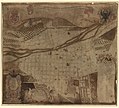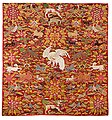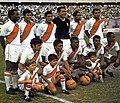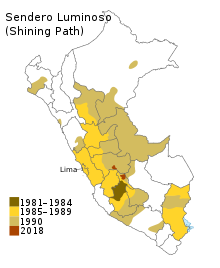Portal:Peru
Introduction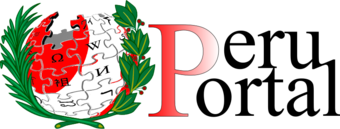
Peru, officially the Republic of Peru, is a country in western South America. It is bordered in the north by Ecuador and Colombia, in the east by Brazil, in the southeast by Bolivia, in the south by Chile, and in the south and west by the Pacific Ocean. Peru is a megadiverse country with habitats ranging from the arid plains of the Pacific coastal region in the west to the peaks of the Andes mountains extending from the north to the southeast of the country to the tropical Amazon basin rainforest in the east with the Amazon River. Peru has a population of over 32 million, and its capital and largest city is Lima. At 1,285,216 km2 (496,225 sq mi), Peru is the 19th largest country in the world, and the third largest in South America. Peruvian territory was home to several cultures during the ancient and medieval periods, and has one of the longest histories of civilization of any country, tracing its heritage back to the 10th millennium BCE. Notable pre-colonial cultures and civilizations include the Caral–Supe civilization (the earliest civilization in the Americas and considered one of the cradles of civilization), the Nazca culture, the Wari and Tiwanaku empires, the Kingdom of Cusco, and the Inca Empire, the largest known state in the pre-Columbian Americas. The Spanish Empire conquered the region in the 16th century and Charles V established a viceroyalty with the official name of the Kingdom of Peru that encompassed most of its South American territories, with its capital in Lima. Higher education started in the Americas with the official establishment of the National University of San Marcos in Lima in 1551. Peru's population includes Mestizos, Amerindians, Europeans, Africans and Asians. The main spoken language is Spanish, although a significant number of Peruvians speak Quechuan languages, Aymara, or other Indigenous languages. This mixture of cultural traditions has resulted in a wide diversity of expressions in fields such as art, cuisine, literature, and music. (Full article...) Entries here consist of Good and Featured articles, which meet a core set of high editorial standards.
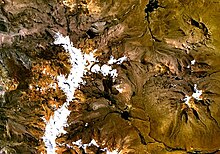 Casiri, also known as Paucarani, is an about 5,650 metres (18,537 ft) high complex volcano in the Barroso mountain range of the Andes, in the Tacna Region of Peru. It consists of four individual volcanic edifices with lava domes; the southeasternmost edifice has been active during the Holocene, producing thick lava flows that have overrun moraines of Pleistocene age. The youngest lava flow has been dated to 2,600 ± 400 years ago. Although no historical eruptions are known, the volcano is considered to be potentially active and is monitored. The volcano features geothermal manifestations and is linked to a larger geothermal field that has been prospected for geothermal power generation. There are two sulfur mines on the volcano, and the Paucarani reservoir that contains the bulk of Tacna's water supply is associated with Casiri: The Rio Uchusuma that flows through the reservoir originates on the volcano and the reservoir is located on the foot of Casiri. (Full article...)Selected image Photo credit: Allard Schmidt
Machu Picchu (Quechua: Machu Pikchu "Old Peak") is a pre-Columbian Inca city located at 2,430 m (7,970 ft) altitude on a mountain ridge above the Urubamba Valley in Peru, about 70 km (44 mi) northwest of Cusco. It was built around the year 1450 and abandoned a hundred years later, at the time of the Spanish conquest of Peru. Forgotten for centuries the site was brought to worldwide attention in 1911 by Hiram Bingham. Since then, it has become an important tourist attraction; it was declared a UNESCO World Heritage Site in 1983. (more...) Selected battleThe Battle of Ollantaytambo took place in January 1537 between the forces of the Inca emperor Manco Inca and a Spanish expedition led by Hernando Pizarro during the Spanish conquest of Peru. A former ally of the Spaniards, Manco Inca rebelled in May 1536 and laid siege to a Spanish garrison in the city of Cusco. To end the stand-off, the besieged mounted a raid against the emperor headquarters, located in the town of Ollantaytambo. The expedition was commanded by Hernando Pizarro and included 100 Spaniards and some 30,000 Indian auxiliaries against an Inca army of more than 30,000. (more...) In this month
General imagesThe following are images from various Peru-related articles on Wikipedia.
Selected article -The Peruvian conflict is an ongoing armed conflict between the Government of Peru and the Maoist guerilla group Shining Path and its remnants. The conflict began on 17 May 1980, and from 1982 to 1997 the Túpac Amaru Revolutionary Movement waged its own insurgency as a Marxist–Leninist rival to the Shining Path. As fighting intensified in the 1980s, the Peruvian government had one of the worst human rights records in the Western Hemisphere; Peru experienced the most forced disappearances in the world during the period while the Peruvian Armed Forces acted with impunity throughout the conflict, sometimes massacring entire villages. It is estimated that there have been between 50,000 and 70,000 deaths, making it the bloodiest war in Peruvian history, since the European colonization of the country. The high death toll includes many civilian casualties, due to deliberate targeting by many factions. The Indigenous peoples of Peru were specifically targeted by killings, with 75% of those killed speaking Quechua as their native language. Since 2000, the number of deaths has dropped significantly and recently the conflict has become dormant. (Full article...)Did you know (auto-generated) -
CategoriesRelated portalsSelected quote -
South American revolutionary leader, liberator and dictator of Peru Simón Bolívar 1783–1830
Basic facts & figuresMore did you know...
Peru TopicsRecognized content
Featured articlesFeatured listsGood articles
WikiProjectsThings you can do
New articlesThis list was generated from these rules. Questions and feedback are always welcome! The search is being run daily with the most recent ~14 days of results. Note: Some articles may not be relevant to this project.
Rules | Match log | Results page (for watching) | Last updated: 2024-05-15 21:23 (UTC) Note: The list display can now be customized by each user. See List display personalization for details.
Associated WikimediaThe following Wikimedia Foundation sister projects provide more on this subject:
Discover Wikipedia using portals | |||||||||||||||





